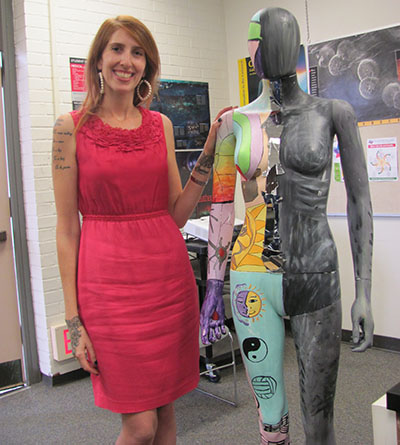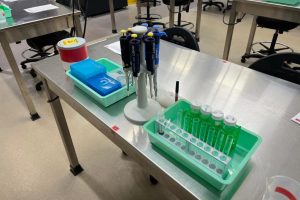Expert informs students about eating disorders

Rachel Sherwyn, program director at a treatment center, stands next to kaleidoscope, an artistic figure that represents an individual with an eating disorder on March 3, in PS 202. Sherwyn gave her talk on “The Reality of Eating Disorders” on the same day.
March 7, 2016
Being informed about eating disorders was one of the topics covered in the latest lecture of the Year of Wellness lecture series.
With nearly every seat occupied, Rachel Sherwyn, program director for the Outpatient Eating Disorder program at the La Ventana Treatment Center, gave her talk on “The Reality of Eating Disorders,” on March 3.
The lecture’s main goal was to spread awareness about eating disorders and to help individuals who may have them.
“I try to push for education on this topic so people can help their friends and their family members who could be struggling with an eating disorder,” said Sherwyn.
One of the topics that Sherwyn touched on was excessive exercising in order to achieve a certain figure. Sherwyn explained that certain methods for achieving a specific body type can sometimes be very dangerous if you’re not aware of the potential consequences.
“Recently I’ve been into compulsive exercising,” said Mersedeh Kolyaei, a 19-year-old anthropology major who attended the lecture. “The information was very helpful. Sherwyn made me realize what I was doing.”
A key element that Sherwyn elaborated on was how some eating disorders can be traced to genetic variables. She wants to make sure that the facts regarding eating disorders are presented with no miscommunication and in complete accuracy.
Sherwyn said she tries to spread knowledge through her work whenever possible.
“These lectures are really cool because I have people that come up afterwards and tell me that they have an eating disorder,” said Sherwyn. “I help clarify any questions they might have and give them information so that they can help other people who might have an eating disorder.”
Sherwyn also talked about different types of eating disorders such as bulimia, anorexia nervosa, purging, muscle dysmorphia, binge eating, as well as the stigmas that come with them.
“I want to keep creating awareness and working in treatment centers helping people to heal,” said Sherwyn. “I’m all about body image and [how] the media portray body image – changing how we interact with it and creating education about it.”







